Triangular trade, or Triangle trade, was a system that facilitated black slavery on a global scale. The system spanned three continents: Ships loaded with goods were sent from Europe to Africa. There, merchants sold them and filled them with black slaves before sailing to the Americas, where they were sold and merchants filled their warehouses with exotic goods such as cotton, rum, coffee, cocoa and sugar. Finally, the ships sailed back to Europe and the cycle began again.
- Causes of Triangular Trade
- The Three Stages of the Triangular Trade
- When and Where Did the Triangular Trade Take Place?
- How Were Slaves Treated in the Triangular Trade?
- How Many Slaves Were Taken in the Triangular Trade?
- Flag of Vessels Carrying the Slaves
- The Prices of Slaves Between 1440 and 1870
- When and How Did the Triangular Trade End?
- What Were the Consequences of the Triangular Trade?
Even if slavery existed before the triangular trade, this is a turning point in history in terms of the scale and logistics of organization. It was a well-functioning system that continued for several centuries, from the 15th to the 19th century, and intensified in the 18th century. The three most profitable countries from this trade were Britain, France and Portugal. The description of the triangular trade also helps us to understand the foundations of the European colonies established in America, which benefited from a large and free labor force thanks to slavery.
Causes of Triangular Trade
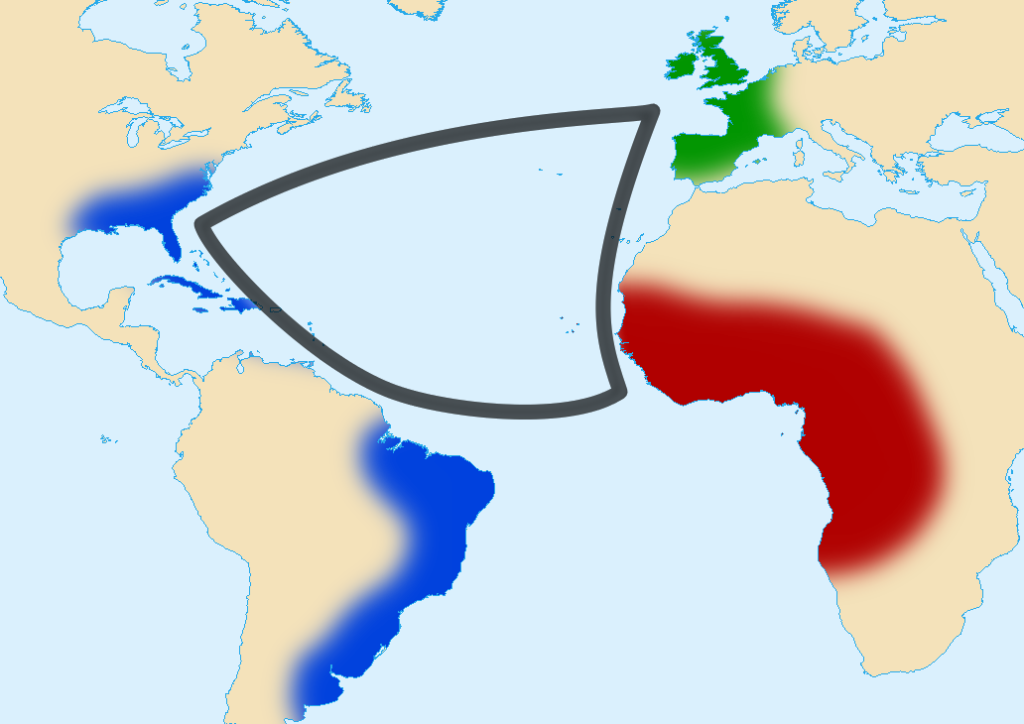
The main reason for the triangular trade was the need for durable labor. This is why the Portuguese bought black Africans in the 15th century. These slaves were not only employed in Portugal but also on merchant ships. The Portuguese were great travelers, trading all over the world. These long journeys led to high mortality rates because the Portuguese, unlike the Africans, could not tolerate the tropical climate of the colonies (Cape Verde, Sao Tomé, Principe, etc.).
The Spanish followed in the Portuguese footsteps and filled their American possessions with slaves to work in the fields and mines. While the existing natives could not withstand this grueling labor, the Africans proved to be more resilient.
The Three Stages of the Triangular Trade
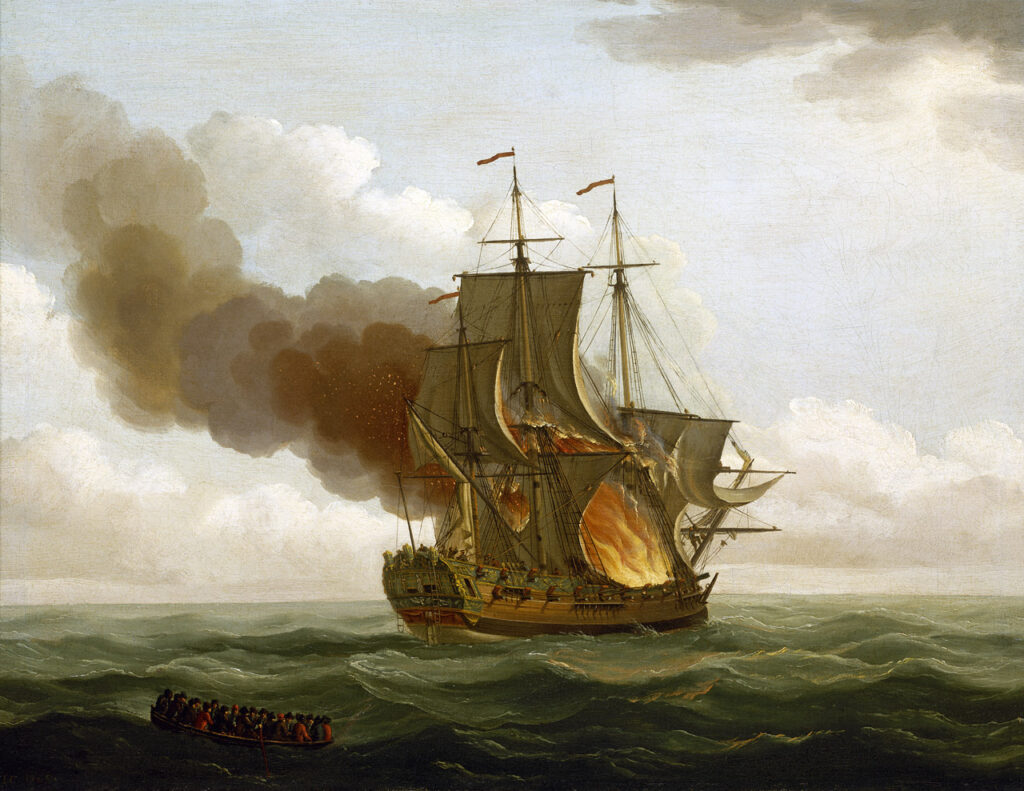
The Triangular Trade involved three main routes: European ships carrying manufactured goods sailed to Africa, where these goods were traded for enslaved Africans. The enslaved Africans were then transported to the Americas as part of the transatlantic slave trade. In the Americas, they were forced to work on plantations, producing goods like sugar, tobacco, and cotton. The raw materials from the Americas were shipped back to Europe to complete the triangle. The main commodities exchanged in the Triangular Trade included European manufactured goods (such as textiles, firearms, and alcohol), enslaved Africans, and colonial products like sugar, tobacco, cotton, and other raw materials.
When and Where Did the Triangular Trade Take Place?
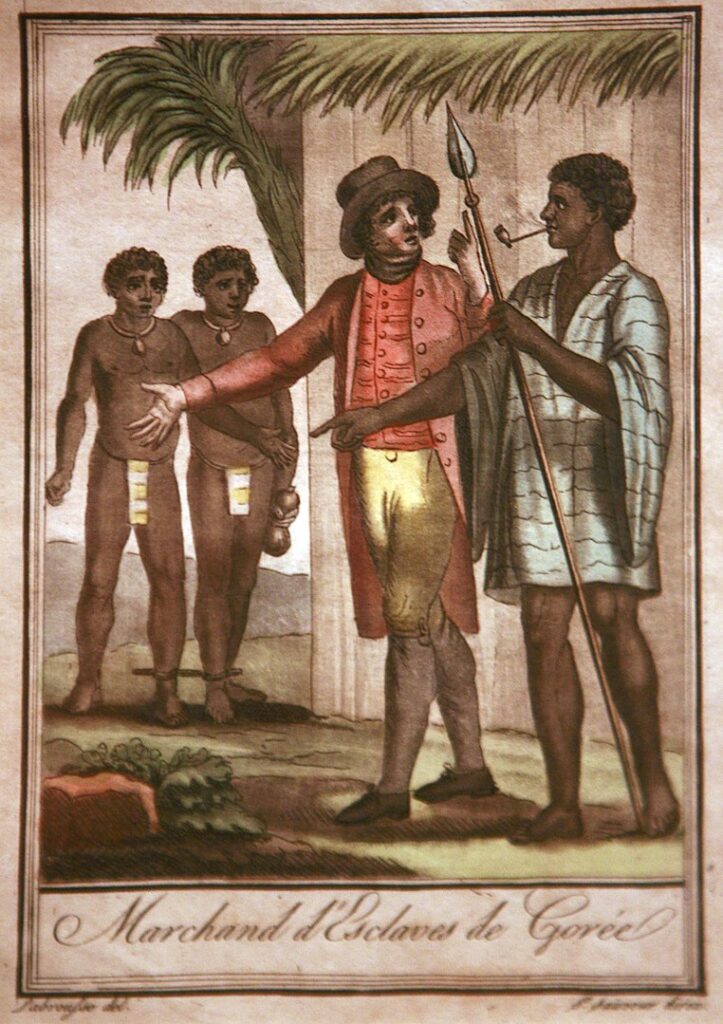
Between the 15th and mid-16th centuries, the triangular trade was taking shape. The demand for slaves was still low and Spain and Portugal were the main suppliers of slaves, which were mostly sold in Hispaniola (now the Dominican Republic) in the Americas. With the arrival of the French and English on the African coast in 1674, the situation changed and competition increased. Slave prices rose, sources of supply changed, and slaves were sold mainly in Jamaica, Santo Domingo, Barbados, Guadeloupe, and Martinique to increase sugar cane production.
The 18th century was a period of great expansion for the triangular trade. Liverpool in England, Nantes and Bordeaux in France were the major slave trading ports in Europe, surpassed only by Rio de Janeiro, the world’s leading port. The slave trade went into decline in the 19th century: the Kings of Denmark and Norway banned the import of slaves in 1803, France abolished the slave trade in 1794 (reinstated by Napoleon Bonaparte in 1802), and then in 1807 it was the British turn. But the abolition of the slave trade did not mean the abolition of slavery, and the trade continued to be illegal in many places.
How Were Slaves Treated in the Triangular Trade?
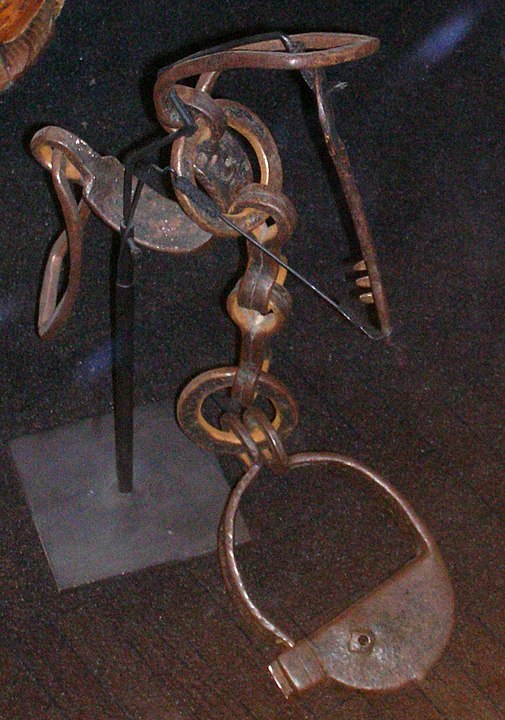
Europeans started by trading black slaves in the interior for the goods they brought with them. Soon, however, military expeditions were organized to capture slaves in Africa. Even middlemen were armed to make it easier for the traders. Conditions during the journey to America, which could take 30 to 80 days depending on the port of departure and destination, were deplorable. Slaves were chained in pairs. Men were separated from women and children. Mortality peaked at 22.6% in the 16th century, then stabilized at around 10% between 1750 and 1864, averaging 11.9%.
Once in America, slaves were sold after a period of quarantine, then isolated from all their roots and families for a period of acclimatization.
They were then given new names. Then, with quotas to meet and the threat of the whip, they went to work on plantations. However, because their masters valued them as a labor force, they did not consistently mistreat them.
Moreover, it was their masters’ duty to Christianize them. For the French, the Code Noir promulgated by Louis XIV in 1685 laid down the rights and duties of masters and slaves.
How Many Slaves Were Taken in the Triangular Trade?
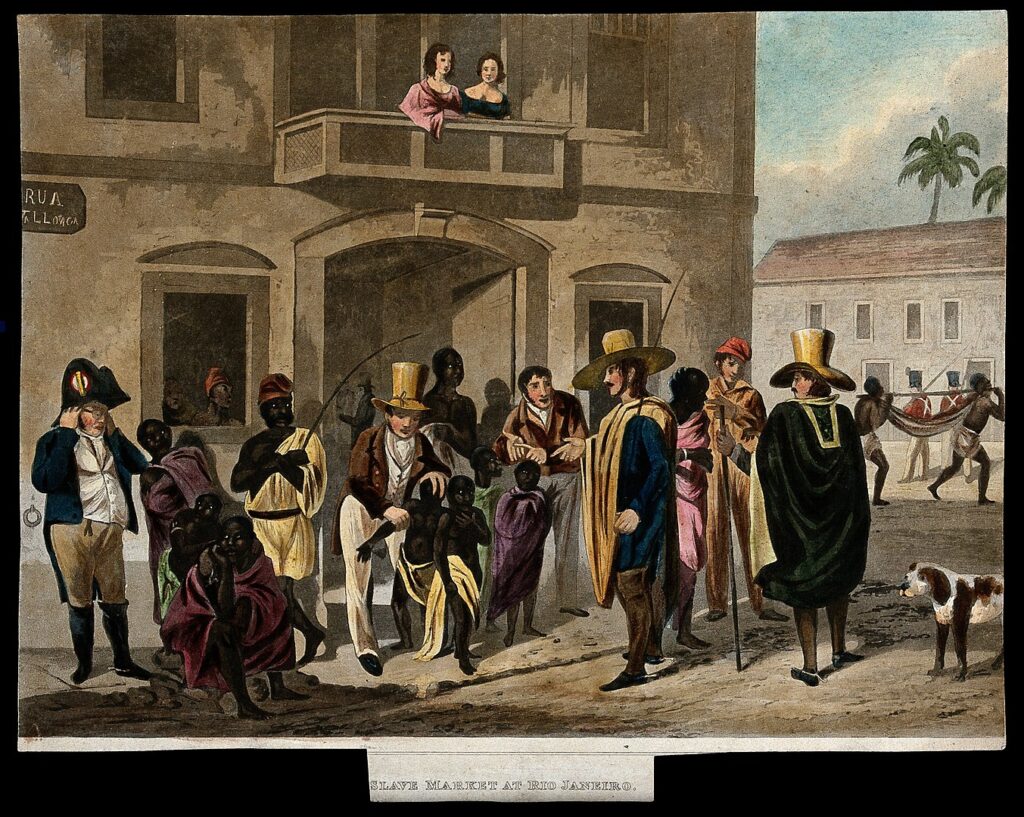
In total, more than 12 million black Africans were deported as part of the triangular trade. About 4.8 million of them came from Central Africa and 2 million from the Gulf of Benin. They were mostly taken to Brazil (4.8 million), the British West Indies (2.3 million) and the French West Indies (1.1 million). France abducted almost one and a half million slaves, far behind Portugal (4.8 million) and Great Britain (3.2 million).
An estimated 12.5 million slaves were transported from Africa to colonies in North and South America, according to research provided by Emory University. The website Voyages: The Trans-Atlantic Slave Trade Database brings together data on the slave trade from Africa in the past. It shows that the top four countries were Portugal, Great Britain, France, and Spain.
Flag of Vessels Carrying the Slaves
| Destination | Portuguese | British | French | Spanish | Dutch | American | Danish | Total |
|---|---|---|---|---|---|---|---|---|
| Portuguese Brazil | 4,821,127 | 3,804 | 9,402 | 1,033 | 27,702 | 1,174 | 130 | 4,864,372 |
| British Caribbean | 7,919 | 2,208,296 | 22,920 | 5,795 | 6,996 | 64,836 | 1,489 | 2,318,251 |
| French Caribbean | 2,562 | 90,984 | 1,003,905 | 725 | 12,736 | 6,242 | 3,062 | 1,120,216 |
| Spanish Americas | 195,482 | 103,009 | 92,944 | 808,851 | 24,197 | 54,901 | 13,527 | 1,292,911 |
| Dutch Americas | 500 | 32,446 | 5,189 | 0 | 392,022 | 9,574 | 4,998 | 444,729 |
| United States | 382 | 264,910 | 8,877 | 1,851 | 1,212 | 110,532 | 983 | 388,747 |
| Danish West Indies | 0 | 25,594 | 7,782 | 277 | 5,161 | 2,799 | 67,385 | 108,998 |
| Europe | 2,636 | 3,438 | 664 | 0 | 2,004 | 119 | 0 | 8,861 |
| Africa | 69,206 | 841 | 13,282 | 66,391 | 3,210 | 2,476 | 162 | 155,568 |
| did not arrive | 748,452 | 526,121 | 216,439 | 176,601 | 79,096 | 52,673 | 19,304 | 1,818,686 |
| Total | 5,848,266 | 3,259,443 | 1,381,404 | 1,061,524 | 554,336 | 305,326 | 111,040 | 12,521,339 |
The Prices of Slaves Between 1440 and 1870
Prices evolved over the course of four centuries of Western African slave trade, both on the English and French sides.
The arrival of the French and the English in 1674 on the African coast, previously dominated by the Dutch, abruptly raised the price of slaves. This price multiplied by six between the mid-17th century and 1712, leading to the development of new supply routes within the continent, weakening traditional African societies.
The mass arrival of new slaves in the Caribbean simultaneously lowered their purchase price for sugarcane plantation owners, increasing production, which resulted in reducing the price of this commodity on the world market and encouraging its consumption. This, in turn, led to a significant expansion of the sugar economy and the slave trade.
On the English and Spanish side, Hugh Thomas presents the following list:
- 1440s: In Senegambia, a horse was worth 25 to 30 slaves.
- 1500: A slave was worth 12 to 15 manillas on the Guinea coast.
- 1500-1510: In Senegambia, a horse was worth 6 to 8 slaves; in Benin, a slave was worth 20 to 25 manillas.
- 1698: In Guinea, prices had increased by 3 to 4 British pounds.
- 1701: In Calabar, a man was worth 12 bars, and a woman was worth 9 bars.
- 1750s: From 12 to 16 pounds at the mouth of the Gambia.
- 1753: A slave from the Gold Coast was worth 46 pounds; from the Windward Coast, from 35 to 43.
- 1801-1810: The average price of a Senegambia slave was 29 pounds 5 shillings, 2 and a half pence.
- 1850: In Saint Louis, Senegal, the average price was 28 British pounds.
- 1851: The price of slaves in Mozambique was about 3 to 5 dollars; in Pongas, about 12; in Luanda, about 14 to 16.
On the French side, historian Serge Daget (1927-1992) also provides the following information:
- In the mid-17th century, in Ouidah, the cost of an average captive was equivalent to 72 livres tournois.
- In 1670, in Ouidah, the cost of an average captive rose to 192 livres.
- In 1712, on the Gold Coast, a captive cost 384 to 410 livres tournois.
- By the end of the 18th century, in Ouidah, it could reach 480 livres.
- Between 1830 and 1840, in Ouidah and Lagos, a captive was worth 360 to 480 francs.
- In 1847, in Ouidah, it cost 1,680 to 1,920 francs.
- In 1847, in Lagos, the cost of a captive was 480 francs.
When and How Did the Triangular Trade End?
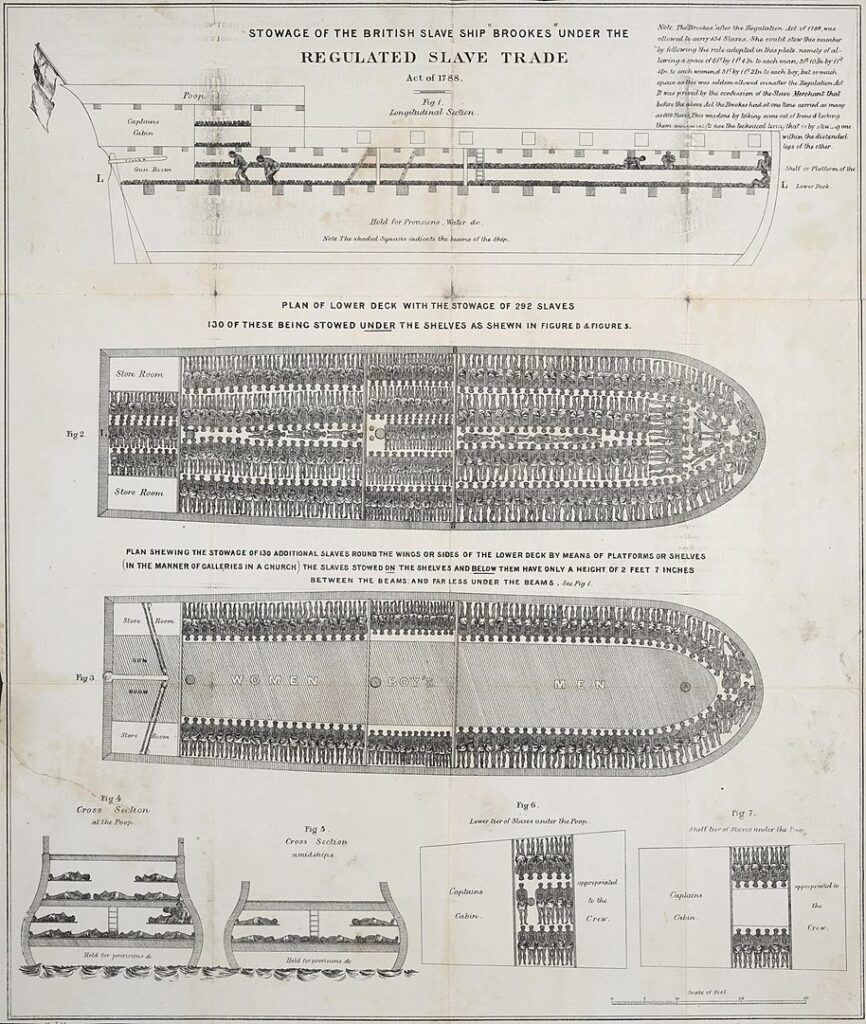
At the end of the 18th century, protests against the slave trade became increasingly vocal. Slaves revolted in the colonies. In France, the slave trade was first abolished in 1794, then reinstated by Napoleon in 1802 and abolished again by the Congress of Vienna in 1815. Slavery was definitively outlawed in France in 1848. In Great Britain, the slave trade ended in 1807 and in the United States, in 1863, following the American Civil War. The independence of Latin American countries accelerated the process, and slavery was abolished in Chile in 1823, Cuba in 1886, and Brazil in 1888.
What Were the Consequences of the Triangular Trade?
After enriching Europeans for several centuries, the slave trade paved the way for colonization. The triangular trade also altered the demographic composition of the Americas, where people of African origin are highly present in certain countries. Their integration after the abolition of slavery did not occur without difficulty.
Racial segregation in the United States is one example of this. In Africa, the massive deportation of young inhabitants of working age hindered economic development, encouraged conflicts between Africans in exchange for weapons, and led to population movements.
After the end of the triangular trade, there was a social, economic, and political decline in the affected regions of Africa, accompanied by more violent interactions among the population.
Key Dates of the Triangular Trade
October 12, 1492 – Christopher Columbus Discovers America
After two months of sailing, Christopher Columbus and his three caravels (the Nina, the Pinta, and the Santa Maria) reached land. However, it wasn’t Asia, as Columbus had hoped; it was the island of Guanahani in the Bahamas, which he claimed in the name of the King and Queen of Spain. This date is now Spain’s national holiday. The colonization of these new lands would lead to a massive demand for labor, pushing Europeans to source slaves from Africa.
February 12, 1635 – Creation of the Company of the American Islands
In 1626, sailors Pierre Belain d’Esnambuc and de Roissey proposed the creation of a “Company of the Lords of Saint-Christophe” to King Louis XIII, with support from Cardinal Richelieu. It was officially founded on July 12, 1635, under the name “Company of the American Islands,” with the goal of expanding French presence and commerce in the Caribbean. In 1649, Charles Houël du Petit Pré purchased Guadeloupe and Les Saintes. The company thrived largely due to the triangular trade and the importation of slaves for the sugar cane plantations.
March 11, 1671 – Foundation of the Danish West India Company
After colonizing the American Virgin Islands and establishing themselves in Saint-Thomas in 1670, the Danes founded the Danish West India Company. It operated on the triangular trade model, exchanging African slaves for sugar and molasses. In 1754, the Danish government took over the company. In 1765, the Guinea Company was created, but economic problems led to its dissolution in 1776.
November 8, 1673 – Colbert Founds the Senegal Company
Under the orders of King Louis XIV, Jean-Baptiste Colbert founded the Senegal Company to take advantage of the flourishing triangular trade dominated by the Dutch. It replaced the West India Company. Its first director was Jean-Baptiste du Casse. However, the company became a financial ruin, as the lack of a monopoly led to an increase in slave traders and a significant rise in the price of African slaves.
August 23, 1791 – Slave Revolt in Haiti
Led by the voodoo priest Boukman, the revolt was the first successful slave uprising. The insurrection began in the northern part of the island and soon spread. Haiti, a major French colony producing sugar and coffee, gained its independence in 1804 after 13 years of battle, forming the first Black state.
February 3, 1794 – The Convention Abolishes Slavery
The French revolutionaries were not immediately in favor of abolishing slavery. The law was drafted by deputy Lacroix of Eure-et-Loir and was passed amid cheers. Representatives from Haiti (then known as Saint-Domingue), which had experienced a major revolt, were present. In 1802, Napoleon reinstated slavery, which was not fully abolished until 1848 under the Second Republic.
March 2, 1807 – England Bans the Slave Trade
The British abolished the trade of Black slaves between Africa and America. Denmark had already implemented this measure three years earlier. England pressured all European nations to renounce the slave trade and did not hesitate to search suspected slave ships, acting as “sea police.” In 1833, England became one of the first countries to definitively abolish slavery.
August 1833 – Abolition of Slavery in the British Empire
By 1833, abolitionist sentiments were growing in Britain, with the government receiving more than 5,000 petitions demanding the end of slavery, representing over a million and a half signatures. In August 1833, the British Empire proclaimed the abolition of slavery in its colonies. Parliament passed the Abolition Bill on August 8, which was confirmed by King William IV on August 28.
April 27, 1848 – Abolition of Slavery in French Colonies
Slavery was first abolished during the French Revolution in 1792, thanks to Henri Grégoire. However, it was restored under Napoleon Bonaparte. In 1848, during the provisional government of the Second Republic, the measure was permanently adopted. Victor Schœlcher, undersecretary to Minister François Arago, played a key role in passing the decree abolishing slavery in the French colonies on April 27, 1848.
September 22, 1862 – Lincoln Proclaims the Emancipation of Southern Slaves
Following the Union victory at Antietam, U.S. President Abraham Lincoln announced the emancipation of Black slaves in the Southern states. This did not outright abolish slavery; slaves in rebellious states were declared free without compensation to their owners, while slaves in border states loyal to the Union saw a more gradual emancipation process. Lincoln set January 1, 1863, as the deadline for emancipation.
January 31, 1865 – Abolition of Slavery in the United States
On this date, the U.S. Constitution was amended with the 13th Amendment, officially and definitively ending slavery. Three years earlier, Lincoln had already emancipated the American slaves, earning him the title of “The Great Emancipator.” His commitment to this cause led to his assassination in 1865, shortly after being re-elected, by a Confederate sympathizer.


